《经济学人》双语阅读1.服装零售
- 格式:docx
- 大小:16.24 KB
- 文档页数:3
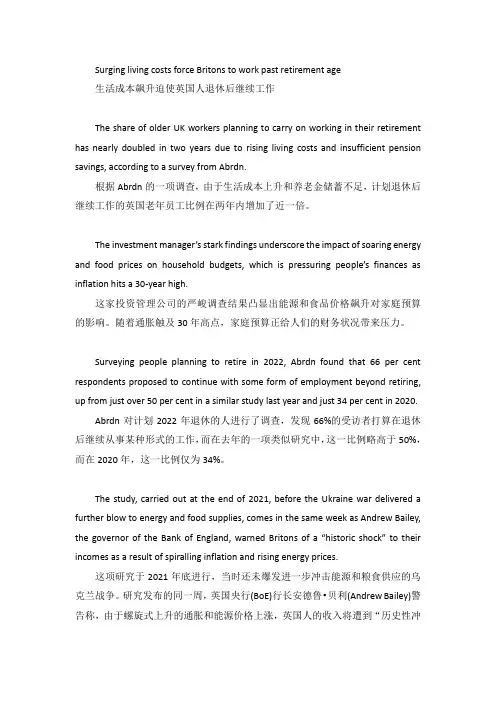
Surging living costs force Britons to work past retirement age生活成本飙升迫使英国人退休后继续工作The share of older UK workers planning to carry on working in their retirement has nearly doubled in two years due to rising living costs and insufficient pension savings, according to a survey from Abrdn.根据Abrdn的一项调查,由于生活成本上升和养老金储蓄不足,计划退休后继续工作的英国老年员工比例在两年内增加了近一倍。
The investment manager’s stark findings underscore the impact of soaring energy and food prices on household budgets, which is pressuring people’s finances as inflation hits a 30-year high.这家投资管理公司的严峻调查结果凸显出能源和食品价格飙升对家庭预算的影响。
随着通胀触及30年高点,家庭预算正给人们的财务状况带来压力。
Surveying people planning to retire in 2022, Abrdn found that 66 per cent respondents proposed to continue with some form of employment beyond retiring, up from just over 50 per cent in a similar study last year and just 34 per cent in 2020.Abrdn对计划2022年退休的人进行了调查,发现66%的受访者打算在退休后继续从事某种形式的工作,而在去年的一项类似研究中,这一比例略高于50%,而在2020年,这一比例仅为34%。

The Economist August 29th 2020 Business 55Depending on whom you ask, Califor-nia is a leader in clean energy or a cau-tionary tale. Power outages in August prompted stern critiques from Republi-cans. “In California”, D onald Trump tweeted, “D emocrats have intentionally implemented rolling blackouts—forcing Americans in the dark.” In addition to pro-voking outrage and derision, however, the episode is also likely to inspire investment.The Golden State has long been Ameri-ca’s main testing ground for green compa-nies. Californians buy half of all electric cars sold in America. Theirs is the country’s largest solar market. As California deals with heat waves, fires and a goal of carbon-free electricity by 2045, the need for a reli-able grid is becoming ever more obvious.For years firms competed to generate clean power in California. Now a growing num-ber are vying to store and manage it, too. August’s blackouts have many causes,including poor planning, an unexpected lack of capacity and sweltering heat in not just California but nearby states from which it sometimes imports power. Long before the outages, however, electricity op-erators were anxious about capacity. Cali-fornia’s solar panels become less useful in the evening, when demand peaks. In No-vember state regulators mandated that utilities procure an additional 3.3 gigawatts (gw ) of capacity, including giant batteries that charge when energy is abundant and can sell electricity back to the grid.Too few such projects have come online to cope with the surge in demand for air-conditioning in the scorching summer. But more are sprouting across the state. On Au-gust 19th ls Power, an electricity firm backed by private equity, unveiled a 250-megawatt (mw ) storage project in San Die-go, the largest of its kind in America. In July the county of Monterey said Vistra Energy,a Texan power company, could build as much as 1.2gw of storage.The rooftop solar industry stands to benefit from a new Californian mandate that requires new homes to install panels on their roofs from this year. Sunrun, the market leader, is increasingly pairing such residential installations with batteries. In July, for instance, the company said it had won contracts with energy suppliers in the Bay Area to install 13mw of residential solar and batteries. These could supply power to residents in a blackout or feed power into the grid to help meet peak demand. Sunrunis so confident in its future that it has bid $3.2bn for Vivint Solar,its main rival.Another way to stave offoutages is to curb demand.Enel,a European power company,has contracts with local utilities to work with large commercial and indus-trial clients.When demand rises,Enel pays customers to reduce energy consumption,easing demand on the grid.A company called OhmConnect offers something sim-ilar for homeowners.Even as such offerings scale up,the need for reliability means that fossil fuels will not disappear just yet.On September 1st California’s regulators will vote on whether to delay the retirement of four natural-gas plants in light of the outages.The state remains intent on decarbonising its power system over the next 25years.But progress may not move in a straight line.7NEW YO RKBusinesses compete to battle California’s blackoutsEnergy utilitiesLitMany big companies may be struggling with depressed sales, but these are busy times for bribery-busters. Mexico is abuzz over allegations by an ex-boss of Pe-mex, the state oil giant, that several senior politicians received bungs from compa-nies including Odebrecht, a Brazilian con-struction firm (see Americas section). The scandal is the latest in a string of graft cases to make headlines this year, starting with Airbus’s record $4bn settlement in January over accusations of corruption for making illegal payments in various countries.Corporate bribery is hardly new. In sur-veys, between a third and a half of compa-nies typically claim to have lost business to rivals who won contracts by paying kick-backs. But such perceptions-based re-search has obvious limitations. A new study takes a more rigorous approach, and draws some striking conclusions.Raghavendra Rau of Judge Business School at the University of Cambridge, Yan-Leung Cheung of the Education University of Hong Kong and Aris Stouraitis of Hong Kong Baptist University examined nearly 200 prominent bribery cases in 60 coun-tries between 1975 and 2015. For the firms doing the bribing, they found, the short-term gains were juicy: every dollar of bribe translated into a $6-9 increase in excess re-turns, relative to the overall stockmarket. That, however, does not take account of the chances of getting caught. These have risen as enforcement of America’s 43-year-old anti-bribery law, the Foreign Corrupt Practices Act (fcpa ), has been stepped up and other countries have passed similar laws. The number of fcpa cases is up sharply since the financial crisis of 2007-09, according to Stanford Law School (see chart). It has dipped a bit under Presi-dent Donald Trump, who has criticised the fcpa for hobbling American firms over-seas, but remains well above historic lev-els. Total fines for fcpa violations were $14bn in 2016-19, 48 times as much as in the four years to 2007.The authors also tested 11hypotheses that emerged from past studies of bribery.They found support for some, for instance that firms pay larger bribes when they ex-pect to receive larger benefits, and that the net benefits of bribing are smaller in places with more public disclosure of politicians’sources of income.But they punctured other bits of re-ceived wisdom. Most striking, they found no link between democracy and graft. This challenges the “Tullock paradox”, which holds that firms can get away with smaller bribes in democracies because politicians and officials have less of a lock on the sys-tem than those in autocratic countries, and so cannot extract as much rent. Such find-ings will doubtless be of interest to corrup-tion investigators and unscrupulous exec-utives alike. 7Bribery pays—if you don’t get caughtBriberyA closer look at greasy palmsBrown envelopes, big chequesUnited States,Foreign Corrupt Practices ActSources:Stanford Law School;Sullivan &Cromwell*Investigations and enforcement actions †To August6543210605040302010020†10152000059095851977Enforcement actionsSanctions, $bnUtilitiesTransport Communications Basic materials Financial services Consumer goods Aerospace & defence TechnologyIndustrials Health care Oil &gas 100806040200Number of cases* by selected industry1977-2020†。
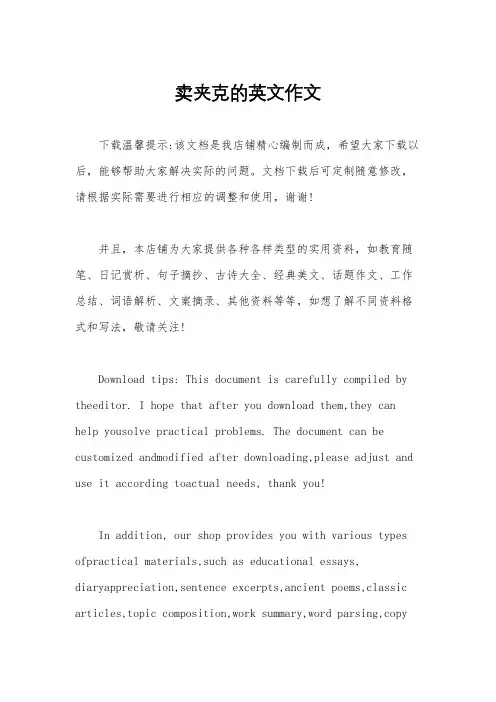
卖夹克的英文作文下载温馨提示:该文档是我店铺精心编制而成,希望大家下载以后,能够帮助大家解决实际的问题。
文档下载后可定制随意修改,请根据实际需要进行相应的调整和使用,谢谢!并且,本店铺为大家提供各种各样类型的实用资料,如教育随笔、日记赏析、句子摘抄、古诗大全、经典美文、话题作文、工作总结、词语解析、文案摘录、其他资料等等,如想了解不同资料格式和写法,敬请关注!Download tips: This document is carefully compiled by theeditor. I hope that after you download them,they can help yousolve practical problems. The document can be customized andmodified after downloading,please adjust and use it according toactual needs, thank you!In addition, our shop provides you with various types ofpractical materials,such as educational essays, diaryappreciation,sentence excerpts,ancient poems,classic articles,topic composition,work summary,word parsing,copyexcerpts,other materials and so on,want to know different data formats andwriting methods,please pay attention!I sell all kinds of jackets. There are different colors and styles. Some are black and look really cool. Some have nice patterns on them.The jackets are made of good materials. They are very comfortable to wear. People like them a lot.We have jackets for different occasions. Whether for going out or for work, there's always a suitable one.The prices of our jackets are reasonable. You can get a great jacket without spending too much money.。
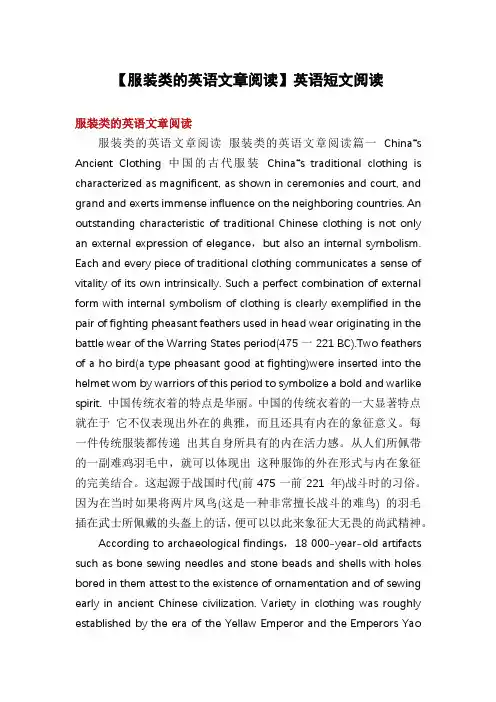
【服装类的英语文章阅读】英语短文阅读服装类的英语文章阅读服装类的英语文章阅读服装类的英语文章阅读篇一China“s Ancient Clothing 中国的古代服装China“s traditional clothing is characterized as magnificent, as shown in ceremonies and court, and grand and exerts immense influence on the neighboring countries. An outstanding characteristic of traditional Chinese clothing is not only an external expression of elegance,but also an internal symbolism. Each and every piece of traditional clothing communicates a sense of vitality of its own intrinsically. Such a perfect combination of external form with internal symbolism of clothing is clearly exemplified in the pair of fighting pheasant feathers used in head wear originating in the battle wear of the Warring States period(475一221 BC).Two feathers of a ho bird(a type pheasant good at fighting)were inserted into the helmet wom by warriors of this period to symbolize a bold and warlike spirit. 中国传统衣着的特点是华丽。
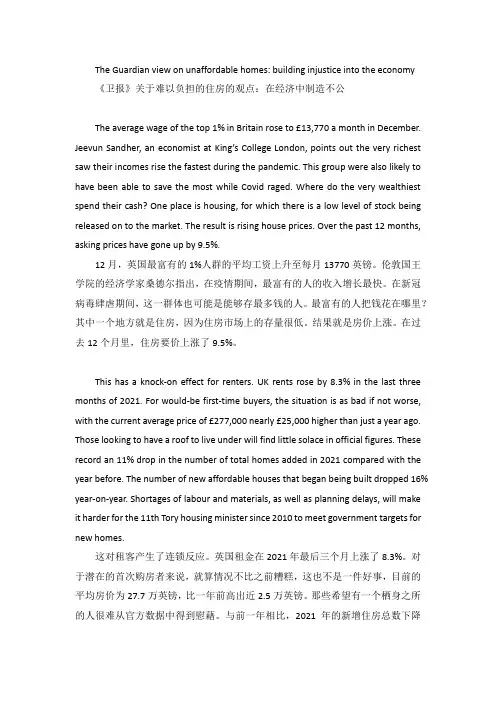
The Guardian view on unaffordable homes: building injustice into the economy《卫报》关于难以负担的住房的观点:在经济中制造不公The average wage of the top 1% in Britain rose to £13,770 a month in December. Jeevun Sandher, an economist at King’s College London, points out the very richest saw their incomes rise the fastest during the pandemic. This group were also likely to have been able to save the most while Covid raged. Where do the very wealthiest spend their cash? One place is housing, for which there is a low level of stock being released on to the market. The result is rising house prices. Over the past 12 months, asking prices have gone up by 9.5%.12月,英国最富有的1%人群的平均工资上升至每月13770英镑。
伦敦国王学院的经济学家桑德尔指出,在疫情期间,最富有的人的收入增长最快。
在新冠病毒肆虐期间,这一群体也可能是能够存最多钱的人。
最富有的人把钱花在哪里?其中一个地方就是住房,因为住房市场上的存量很低。
结果就是房价上涨。
在过去12个月里,住房要价上涨了9.5%。
This has a knock-on effect for renters. UK rents rose by 8.3% in the last three months of 2021. For would-be first-time buyers, the situation is as bad if not worse, with the current average price of £277,000 nearly £25,000 higher than just a year ago. Those looking to have a roof to live under will find little solace in official figures. These record an 11% drop in the number of total homes added in 2021 compared with the year before. The number of new affordable houses that began being built dropped 16% year-on-year. Shortages of labour and materials, as well as planning delays, will make it harder for the 11th Tory housing minister since 2010 to meet government targets for new homes.这对租客产生了连锁反应。

极致的中国式浪漫!2022冬奥会闭幕式再次惊艳世界!2月20日晚,北京第二十四届冬季奥林匹克运动会闭幕式在国家体育场举行。
Closing ceremony of the Beijing 2022 Olympic Winter Games was held at the National Stadium in Beijing on Sunday.这场壮丽的闭幕式,是中国送给全世界的浪漫,重温每一个细节都让人热泪盈眶。
折柳寄情用中国式浪漫说闭幕在北京冬奥会缅怀时刻,现场响起了《送别》的歌声,80名舞者走出一幅“垂柳图”。
365位普通人手捧柳枝惜别冬奥,他们向场地中央汇聚,以这种的方式,演绎中国人传承千年的“惜别怀远”、“折柳寄情”。
在中国古代,送行者往往会折一条柳枝送给远行的亲朋。
折柳也成为了独具东方文化韵味的送别方式。
The "Moment of Remembrance" is a very important part of the Olympic Games' Closing Ceremony, and for this year, the theme "A Willow Twig" presents the segment with Chinese characteristics.In ancient days, when two friends part, the traveling party will always receive a willow twig as a gift. For the closing ceremony of the Beijing Olympics, it was only fitting that the willow twig would be incorporated into the ceremony as the athletes depart to their respective countries.从开幕式上的“迎客松”烟花广迎宾朋,到闭幕式的折柳赠别八方友人,中国人的浪漫久久不绝。
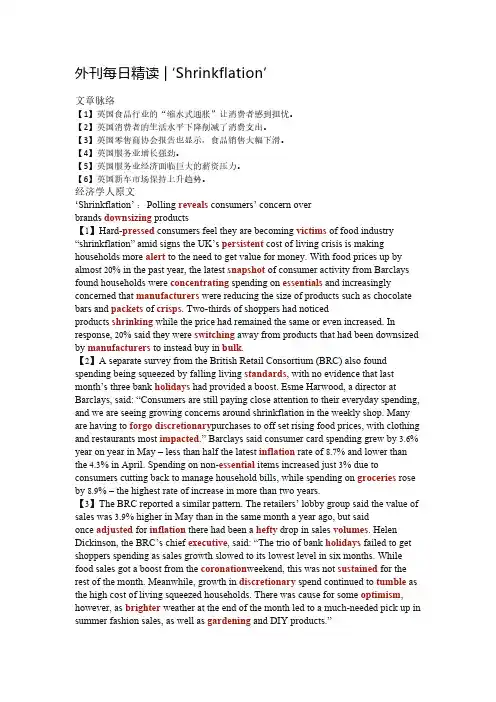
外刊每日精读 | ‘Shrinkflation’文章脉络【1】英国食品行业的“缩水式通胀”让消费者感到担忧。
【2】英国消费者的生活水平下降削减了消费支出。
【3】英国零售商协会报告也显示,食品销售大幅下滑。
【4】英国服务业增长强劲。
【5】英国服务业经济面临巨大的薪资压力。
【6】英国新车市场保持上升趋势。
经济学人原文‘Shrinkflation’ :Polling reveals consumers’ concern overbrands downsizing products【1】Hard-pressed consumers feel they are becoming victims of food industry “shrinkflation” amid signs the UK’s persistent cost of living crisis is making households more alert to the need to get value for money. With food prices up by almost 20% in the past year, the latest snapshot of consumer activity from Barclays found households were concentrating spending on essentials and increasingly concerned that manufacturers were reducing the size of products such as chocolate bars and packets of crisps. Two-thirds of shoppers had noticedproducts shrinking while the price had remained the same or even increased. In response, 20% said they were switching away from products that had been downsized by manufacturers to instead buy in bulk.【2】A separate survey from the British Retail Consortium (BRC) also found spending being squeezed by falling living standards, with no evidence that last month’s three bank holidays had provided a boost. Esme Harwood, a director at Barclays, said: “Consumers are still paying close attention to their everyday spending, and we are seeing growing concerns around shrinkflation in the weekly shop. Many are having to forgo discretionary purchases to off set rising food prices, with clothing and restaurants most impacted.” Barclays said consumer card spending grew by 3.6% year on year in May – less than half the latest inflation rate of 8.7% and lower than the 4.3% in April. Spending on non-essential items increased just 3% due to consumers cutting back to manage household bills, while spending on groceries rose by 8.9% – the highest rate of increase in more than two years.【3】The BRC reported a similar pattern. The retailers’ lobby group said the value of sales was 3.9% higher in May than in the same month a year ago, but saidonce adjusted for inflation there had been a hefty drop in sales volumes. Helen Dickinson, the BRC’s chief executive, said: “The trio of bank holidays failed to get shoppers spending as sales growth slowed to its lowest level in six months. While food sales got a boost from the coronation weekend, this was not sustained for the rest of the month. Meanwhile, growth in discretionary spend continued to tumble as the high cost of living squeezed households. There was cause for some optimism, however, as brighter weather at the end of the month led to a much-needed pick up in summer fashion sales, as well as gardening and DIY products.”【4】The latest monthly health check of the UK’s service sector said rising wages were pushing up business costs and prompting companies to raise prices. TheS&P/Chartered Institute of Procurement and Supply (Cips) purchasing managers’ survey found upward pressure on pay had not prevented strong growth for the sector last month, with the business activity index above 50 for a fourth month. Readings above 50indicate an expanding sector.【5】Tim Moore, the economic indices director at S&P global market intelligence, which compiled the survey, said: “Intense wage pressures continued across the service economy, despite a moderation in employment growth. Higher salary payments more than offset lower fuel costs, which meant that overall inputprice inflation edged up to its strongest for three months in May. Averageprices charged by service sector companies nonetheless increased at the second-weakest pace since August 2021 amid some reports of greater price resistance among clients.”【6】Fresh data from the Society of Motor manufacturers and Traders (SMMT) showed new car registrations rose 16.7% in May to 145,204.While registrations remained 21% below their level in May 2019 – the last year before the start of the Covid -19pandemic – last month’s increase marked the 10th rise ina row, the longest period of uninterrupted growth since 2015. Mike Hawes , the SMMT’s chief executive, said: “After the difficult, Covid-constrained supply issues of the last few years, it’s good to see the new car market maintain its upward trend and the fact that growth is, increasingly, green growth is hugely encouraging.”。
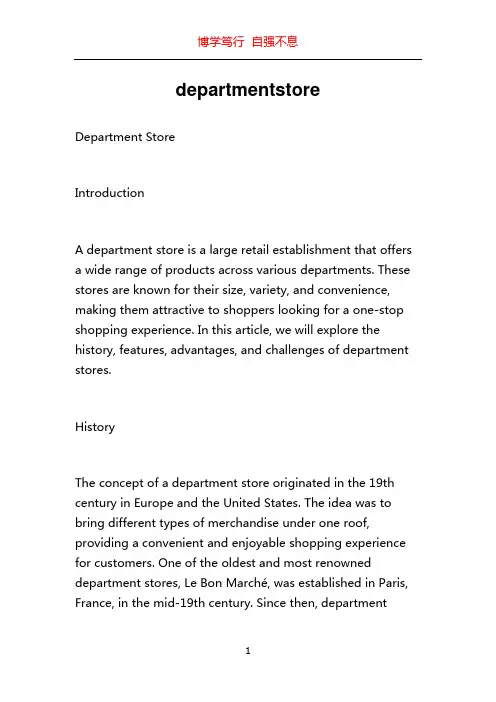
departmentstore Department StoreIntroductionA department store is a large retail establishment that offers a wide range of products across various departments. These stores are known for their size, variety, and convenience, making them attractive to shoppers looking for a one-stop shopping experience. In this article, we will explore the history, features, advantages, and challenges of department stores.HistoryThe concept of a department store originated in the 19th century in Europe and the United States. The idea was to bring different types of merchandise under one roof, providing a convenient and enjoyable shopping experience for customers. One of the oldest and most renowned department stores, Le Bon Marché, was established in Paris, France, in the mid-19th century. Since then, departmentstores have continued to evolve and adapt to changing consumer preferences and market trends.Features of Department StoresDepartment stores are characterized by their vast size and extensive product selection. These stores typically feature multiple floors, each dedicated to a specific department such as clothing, accessories, furniture, home appliances, cosmetics, and more. Customers can find a wide range of brands and products, catering to different tastes, preferences, and budgets. Additionally, department stores often house restaurants, cafes, and other amenities, providing shoppers with a complete shopping and dining experience.Advantages of Department StoresOne of the key advantages of department stores is the convenience they offer. With a wide selection of products available in one location, customers can save time and effort by completing all their shopping in a single trip. Moreover, department stores often provide a higher level of customer service compared to smaller retail outlets. They employ knowledgeable and trained staff who can assist customers infinding the right products, answering queries, and providing personalized assistance.Department stores are also known for their promotional activities and sales events. These stores often offer attractive discounts, seasonal sales, and loyalty programs, incentivizing customers to make purchases. This can be particularly beneficial for budget-conscious shoppers looking for good deals and bargains.Challenges Faced by Department StoresWhile department stores have long been a popular shopping destination, they face certain challenges in the current retail landscape. One significant challenge is the rise of ecommerce and online shopping. Many customers now prefer the convenience of shopping from the comfort of their homes and having products delivered to their doorstep. This shift in consumer behavior has led to a decline in foot traffic and sales for traditional brick-and-mortar stores.Moreover, the competition from specialty stores and discount retailers has intensified. These stores often offer targeted product selections and competitive pricing, drawing customers away from department stores. In response to thesechallenges, department stores are adapting by enhancing their online presence, offering exclusive products, and focusing on creating unique shopping experiences to attract and retain customers.ConclusionDepartment stores have a rich history and have played a significant role in the retail industry. Although they face challenges in today's changing market, department stores continue to evolve and innovate to stay relevant. With their diverse product offerings, convenience, and personalized service, department stores remain a popular choice for many shoppers seeking a comprehensive shopping experience.。
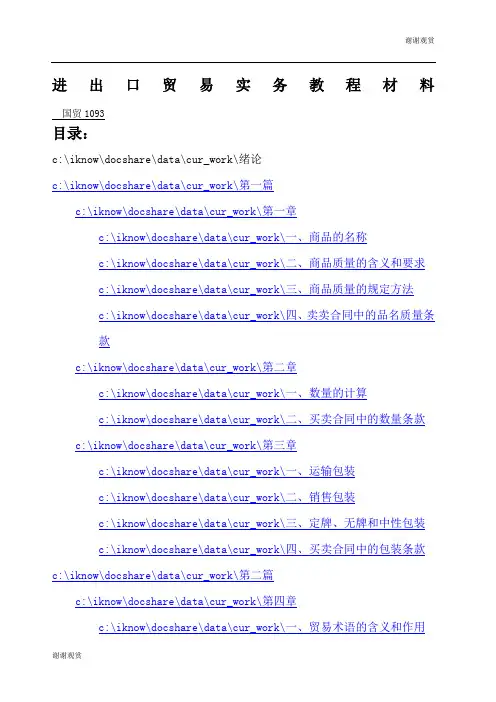
进出口贸易实务教程材料国贸1093目录:c:\iknow\docshare\data\cur_work\绪论c:\iknow\docshare\data\cur_work\第一篇c:\iknow\docshare\data\cur_work\第一章c:\iknow\docshare\data\cur_work\一、商品的名称c:\iknow\docshare\data\cur_work\二、商品质量的含义和要求c:\iknow\docshare\data\cur_work\三、商品质量的规定方法c:\iknow\docshare\data\cur_work\四、卖卖合同中的品名质量条款c:\iknow\docshare\data\cur_work\第二章c:\iknow\docshare\data\cur_work\一、数量的计算c:\iknow\docshare\data\cur_work\二、买卖合同中的数量条款c:\iknow\docshare\data\cur_work\第三章c:\iknow\docshare\data\cur_work\一、运输包装c:\iknow\docshare\data\cur_work\二、销售包装c:\iknow\docshare\data\cur_work\三、定牌、无牌和中性包装c:\iknow\docshare\data\cur_work\四、买卖合同中的包装条款c:\iknow\docshare\data\cur_work\第二篇c:\iknow\docshare\data\cur_work\第四章c:\iknow\docshare\data\cur_work\一、贸易术语的含义和作用c:\iknow\docshare\data\cur_work\二、有关贸易术语的国际惯例c:\iknow\docshare\data\cur_work\三、六种主要贸易术语c:\iknow\docshare\data\cur_work\四、其他五种贸易术语c:\iknow\docshare\data\cur_work\五、本章总结c:\iknow\docshare\data\cur_work\第五章c:\iknow\docshare\data\cur_work\一、作价方法c:\iknow\docshare\data\cur_work\二、计价货币c:\iknow\docshare\data\cur_work\三、计价数量单位与单位价格金额c:\iknow\docshare\data\cur_work\四、贸易术语的选用c:\iknow\docshare\data\cur_work\第六章c:\iknow\docshare\data\cur_work\一、出口商品成本核算c:\iknow\docshare\data\cur_work\二、佣金和折扣c:\iknow\docshare\data\cur_work\第三篇c:\iknow\docshare\data\cur_work\第七章c:\iknow\docshare\data\cur_work\一、c:\iknow\docshare\data\cur_work\二、交货时间c:\iknow\docshare\data\cur_work\三、装运港(地)和目的港(地)c:\iknow\docshare\data\cur_work\四、分批装运和转运c:\iknow\docshare\data\cur_work\五、买卖合同中的装运条款c:\iknow\docshare\data\cur_work\第八章c:\iknow\docshare\data\cur_work\一、海洋运输c:\iknow\docshare\data\cur_work\五、集装箱运输c:\iknow\docshare\data\cur_work\第九章c:\iknow\docshare\data\cur_work\一、保险的基本原则c:\iknow\docshare\data\cur_work\二、货物运输保险保障的范围c:\iknow\docshare\data\cur_work\三、我国海洋运输货物保险的险别与条款c:\iknow\docshare\data\cur_work\五、伦敦保险业协会海运货物保险条款c:\iknow\docshare\data\cur_work\第四篇c:\iknow\docshare\data\cur_work\第十章c:\iknow\docshare\data\cur_work\一、汇票c:\iknow\docshare\data\cur_work\第十一章c:\iknow\docshare\data\cur_work\一、汇付c:\iknow\docshare\data\cur_work\二、托收c:\iknow\docshare\data\cur_work\第十二章c:\iknow\docshare\data\cur_work\一、二、信用证的定义、当事人c:\iknow\docshare\data\cur_work\三、四、信用证主要内容、收付的一般程序c:\iknow\docshare\data\cur_work\五、六、信用证的性质作用、跟单信用证统一惯例c:\iknow\docshare\data\cur_work\七、八、信用证特点、种类c:\iknow\docshare\data\cur_work\第十四章c:\iknow\docshare\data\cur_work\一、选择结算方式应该考虑的因素c:\iknow\docshare\data\cur_work\二、不同结算方式的结合使用c:\iknow\docshare\data\cur_work\三、分期付款与延期付款c:\iknow\docshare\data\cur_work\第十五章c:\iknow\docshare\data\cur_work\一、二、三、汇付条款、托收条款、信用证支付条款c:\iknow\docshare\data\cur_work\第五篇c:\iknow\docshare\data\cur_work\第十六章c:\iknow\docshare\data\cur_work\一、买方的检验权c:\iknow\docshare\data\cur_work\二、检验的时间和地点c:\iknow\docshare\data\cur_work\第十七章c:\iknow\docshare\data\cur_work\一、违约责任c:\iknow\docshare\data\cur_work\二、索赔与理赔c:\iknow\docshare\data\cur_work\三、买卖合同中的索赔条款c:\iknow\docshare\data\cur_work\第十八章c:\iknow\docshare\data\cur_work\一、二、不可抗力的认定和处理、通知和证明c:\iknow\docshare\data\cur_work\第十九章c:\iknow\docshare\data\cur_work\一、二、仲裁的形式和机构、仲裁协议c:\iknow\docshare\data\cur_work\第六篇c:\iknow\docshare\data\cur_work\第二十章c:\iknow\docshare\data\cur_work\一、二、出口交易磋商的形式和内容、一般程序c:\iknow\docshare\data\cur_work\第二十一章班级国贸1093 姓名学号绪论1.国际货物卖卖合同适用的法律有:国内法,国际贸易惯例,国际条约。
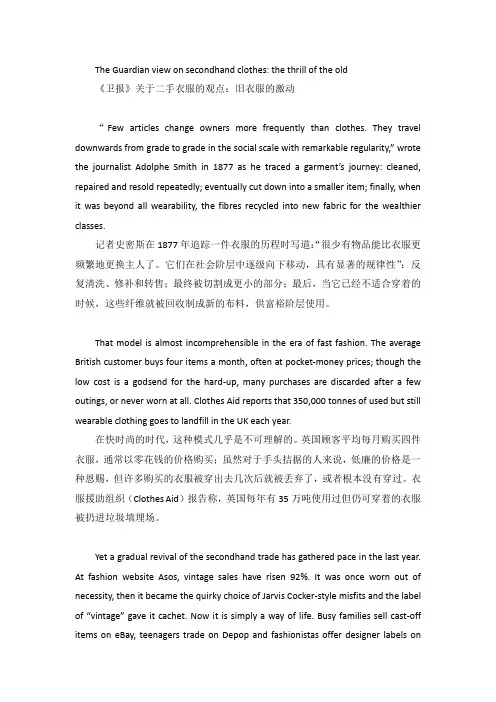
The Guardian view on secondhand clothes: the thrill of the old《卫报》关于二手衣服的观点:旧衣服的激动“Few articles change owners more frequently than clothes. They travel downwards from grade to grade in the social scale with remarkable regularity,” wrote the journalist Adolphe Smith in 1877 as he traced a garment’s journey: cleaned, repaired and resold repeatedly; eventually cut down into a smaller item; finally, when it was beyond all wearability, the fibres recycled into new fabric for the wealthier classes.记者史密斯在1877年追踪一件衣服的历程时写道:“很少有物品能比衣服更频繁地更换主人了。
它们在社会阶层中逐级向下移动,具有显著的规律性”:反复清洗、修补和转售;最终被切割成更小的部分;最后,当它已经不适合穿着的时候,这些纤维就被回收制成新的布料,供富裕阶层使用。
That model is almost incomprehensible in the era of fast fashion. The average British customer buys four items a month, often at pocket-money prices; though the low cost is a godsend for the hard-up, many purchases are discarded after a few outings, or never worn at all. Clothes Aid reports that 350,000 tonnes of used but still wearable clothing goes to landfill in the UK each year.在快时尚的时代,这种模式几乎是不可理解的。
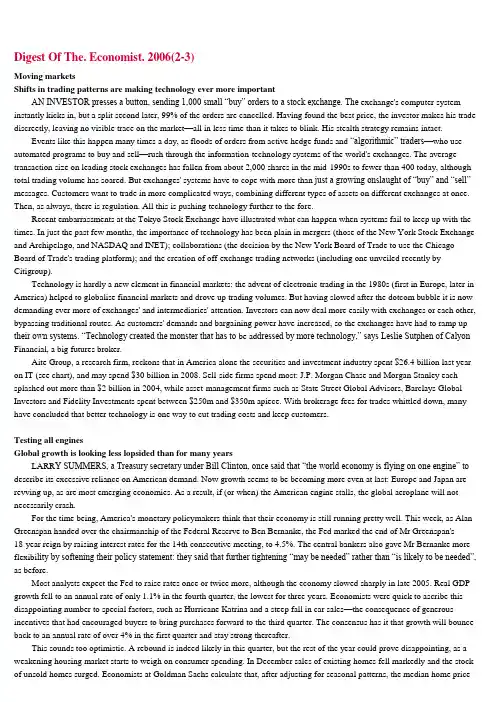
Digest Of The. Economist. 2006(2-3)Moving marketsShifts in trading patterns are making technology ever more importantAN INVESTOR presses a button, sending 1,000 small “buy” orders to a stock exchange. The exchange's computer system instantly kicks in, but a split second later, 99% of the orders are cancelled. Having found the best price, the investor makes his trade discreetly, leaving no visible trace on the market—all in less time than it takes to blink. His stealth strategy remains intact.Events like this happen many times a day, as floods of orders from active hedge funds and “algorithmic” traders—who use automated programs to buy and sell—rush through the information-technology systems of the world's exchanges. The average transaction size on leading stock exchanges has fallen from about 2,000 shares in the mid-1990s to fewer than 400 today, although total trading volume has soared. But exchanges' systems have to cope with more than just a growing onslaught of “buy” and “sell” messages. Customers want to trade in more complicated ways, combining different types of assets on different exchanges at once. Then, as always, there is regulation. All this is pushing technology further to the fore.Recent embarrassments at the Tokyo Stock Exchange have illustrated what can happen when systems fail to keep up with the times. In just the past few months, the importance of technology has been plain in mergers (those of the New York Stock Exchange and Archipelago, and NASDAQ and INET); collaborations (the decision by the New York Board of Trade to use the Chicago Board of Trade's trading platform); and the creation of off-exchange trading networks (including one unveiled recently by Citigroup).Technology is hardly a new element in financial markets: the advent of electronic trading in the 1980s (first in Europe, later in America) helped to globalise financial markets and drove up trading volumes. But having slowed after the dotcom bubble it is now demanding ever more of exchanges' and intermediaries' attention. Investors can now deal more easily with exchanges or each other, bypassing traditional routes. As customers' demands and bargaining power have increased, so the exchanges have had to ramp up their own systems. “Technology created the monster that has to be ad dressed by more technology,” says Leslie Sutphen of Calyon Financial, a big futures broker.Aite Group, a research firm, reckons that in America alone the securities and investment industry spent $26.4 billion last year on IT (see chart), and may spend $30 billion in 2008. Sell-side firms spend most: J.P. Morgan Chase and Morgan Stanley each splashed out more than $2 billion in 2004, while asset-management firms such as State Street Global Advisors, Barclays Global Investors and Fidelity Investments spent between $250m and $350m apiece. With brokerage fees for trades whittled down, many have concluded that better technology is one way to cut trading costs and keep customers.Testing all enginesGlobal growth is looking less lopsided than for many yearsLARR Y SUMMERS, a Treasury secretary under Bill Clinton, once said that “the world economy is flying on one engine” to describe its excessive reliance on American demand. Now growth seems to be becoming more even at last: Europe and Japan are revving up, as are most emerging economies. As a result, if (or when) the American engine stalls, the global aeroplane will not necessarily crash.For the time being, America's monetary policymakers think that their economy is still running pretty well. This week, as Alan Greenspan handed over the chairmanship of the Federal Reserve to Ben Bernanke, the Fed marked the end of Mr Greenspan's18-year reign by raising interest rates for the 14th consecutive meeting, to 4.5%. The central bankers also gave Mr Bernanke more flexibi lity by softening their policy statement: they said that further tightening “may be needed”rather than “is likely to be needed”, as before.Most analysts expect the Fed to raise rates once or twice more, although the economy slowed sharply in late 2005. Real GDP growth fell to an annual rate of only 1.1% in the fourth quarter, the lowest for three years. Economists were quick to ascribe this disappointing number to special factors, such as Hurricane Katrina and a steep fall in car sales—the consequence of generous incentives that had encouraged buyers to bring purchases forward to the third quarter. The consensus has it that growth will bounce back to an annual rate of over 4% in the first quarter and stay strong thereafter.This sounds too optimistic. A rebound is indeed likely in this quarter, but the rest of the year could prove disappointing, as a weakening housing market starts to weigh on consumer spending. In December sales of existing homes fell markedly and the stock of unsold homes surged. Economists at Goldman Sachs calculate that, after adjusting for seasonal patterns, the median home price has fallen by almost 4% since October. Experience from Britain and Australia shows that even a soft landing for house prices can cause an acute slowdown in consumer spending.American consumers have been the main engine not just of their own economy but of the whole world's. If that engine fails, will the global economy nose-dive? A few years ago, the answer would probably have been yes. But the global economy may now be less vulnerable. At the World Economic Forum in Davos last week, Jim O'Neill, the chief economist at Goldman Sachs, argued convincingly that a slowdown in America need not lead to a significant global loss of power.Start with Japan, where industrial output jumped by an annual rate of 11% in the fourth quarter. Goldman Sachs has raised its GDP growth forecast for that quarter (the official number is due on February 17th) to an annualized 4.2%. That would pushyear-on-year growth to 3.9%, well ahead of America's 3.1%. The bank predicts average GDP growth in Japan this year of 2.7%. It thinks strong demand within Asia will partly offset an American slowdown.Japan's labour market is also strengthening. In December the ratio of vacancies to job applicants rose to its highest since 1992 (see chart 1). It is easier to find a job now than at any time since the bubble burst in the early 1990s. Stronger hiring by firms is also pushing up wages after years of decline. Workers are enjoying the biggest rise in bonuses for over a d ecade.Pass the parcelOnline shoppers give parcels firms a new lease of lifeTHINGS must be going well in the parcels business. At $2.5m for a 30-second TV commercial during last weekend's Super Bowl, an ad from FedEx was the one many Americans found the most entertaining. It showed a caveman trying to use a pterodactyl for an express delivery, only to watch it be gobbled up on take-off by a tyrannosaur. What did the world do before FedEx, the ad inquired? It might have asked what on earth FedEx did before the arrival of online retailers, which would themselves be sunk without today's fast and efficient delivery firms.Consumers and companies continue to flock in droves to the internet to buy and sell things. FedEx reported its busiest period ever last December, when it handled almost 9m packages in a single day. Online retailers also set new records in America. Excluding travel, some $82 billion was spent last year buying things over the internet, 24% more than in 2004, according to comScore Networks, which tracks consumer behaviour. Online sales of clothing, computer software, toys, and home and garden products were all up by more than 30%. And most of this stuff was either posted or delivered by parcel companies.The boom is global, especially now that more companies are outsourcing production. It is becoming increasingly common for products to be delivered direct from factory to consumer. In one evening just before Christmas, a record 225,000 international express packages were handled by UPS at a giant new air-cargo hub, opened by the American logistics firm at Cologne airport in Germany. “The internet has had a profound effect on our business,” says David Abney, UPS's international president. UPS now handles more than 14m packages worldwide every day.It is striking that postal firms—once seen as obsolete because of the emergence of the internet—are now finding salvation from it. People are paying more bills online and sending more e-mails instead of letters, but most post offices are making up for that thanks to e-commerce. After four years of profits, the United States Postal Service has cleared its $11 billion of debt.Firms such as Amazon and eBay have even helped make Britain's Royal Mail profitable. It needs to be: on January 1st, the Royal Mail lost its 350-year-old monopoly on carrying letters. It will face growing competition from rivals, such as Germany's Deutsche Post, which has expanded vigorously after partial privatisation and now owns DHL, another big international delivery company.Both post offices and express-delivery firms have developed a range of services to help ecommerce and eBay's traders—who listed a colossal 1.9 billion items for sale last year. Among the most popular services are tracking numbers, which allow people to follow the progress of their deliveries on the internet.A question of standardsMore suggestions of bad behaviour by tobacco companies. MaybeANOTHER round has just been fought in the battle between tobacco companies and those who regard them as spawn of the devil. In a paper just published in the Lancet, with the provocative title “Secret science: tobacco industry research on smoking behaviour and cigarette toxicity”, David Hammond, of Waterloo University in Canada and Neil Collishaw and Cynthia Callard, two members of Physicians for a Smoke-Free Canada, a lobby group, criticise the behaviour of British American Tobacco (BAT). They say the firm considered manipulating some of its products in order to make them low-tar in the eyes of officialdom while they actually delivered high tar and nicotine levels to smokers.It was and is no secret, as BAT points out, that people smoke low-tar cigarettes differently from high-tar ones. The reason is that they want a decent dose of the nicotine which tobacco smoke contains. They therefore pull a larger volume of air through the cigarette when they draw on a low-tar rather than a high-tar variety. The extra volume makes up for the lower concentration of the drug.But a burning cigarette is a complex thing, and that extra volume has some unexpected consequences. In particular, a bigger draw is generally a faster draw. That pulls a higher proportion of the air inhaled through the burning tobacco, rather than through the paper sides of the cigarette. This, in turn, means more smoke per unit volume, and thus more tar and nicotine. The nature of the nicotine may change, too, with more of it being in a form that is easy for the body to absorb.According to Dr Hammond and his colleagues, a series of studies conducted by BAT's researchers between 1972 and 1994 quantified much of this. The standardised way of analysing cigarette smoke, as laid down by the International Organisation for Standardisation (ISO), which regulates everything from computer code to greenhouse gases, uses a machine to make 35-millilitre puffs, drawn for two seconds once a minute. The firm's researchers, by contrast, found that real smokers draw 50-70ml per puff, and do so twice a minute. Dr Hammonds's conclusion is drawn from the huge body of documents disgorged by the tobacco industry as part of various legal settlements that have taken place in the past few years, mainly as a result of disputes with the authorities in the United States.Dr Hammond suggests, however, the firm went beyond merely investigating how people smoked. A series of internal documents from the late 1970s and early 1980s shows that BAT at least thought about applying this knowledge to cigarette design.A research report from 1979 puts it thus: “There are three major design featur es which can be used either individually or in combination to manipulate delivery levels; filtration, paper permeability, and filter-tip ventilation.” A conference paper from 1983 says, “The challenge would be to reduce the mainstream nicotine determined by standard smoking-machine measurement while increasing the amount that would actually be absorbed by the smoker”. Another conference paper, from 1984, says: “We should strive to achieve this effect without appearing to have a cigarette that cheats the league table. Ideally it should appear to be no different from a normal cigarette...It should also be capable of delivering up to 100% more than its machine delivery.”Thanks to the banksCollege students learn more about market ratesA GOOD education may be priceless, but in America it is far from cheap—and it is not getting any cheaper. On February 1st Congress narrowly passed the Deficit Reduction Act, which aims to slim America's bulging budget deficit by, among other things, lopping $12.7 billion off the federal student-loan programme. Interest rates on student loans will rise while subsidies fall.Family incomes, grant aid and federal loans have all failed to keep pace with the growth in the cost of tuition. “The funding gap between what students can afford and what higher education costs has got wider and wider,” says Claire Mezzanotte of Fitch, a ratings agency. Lenders are rushing to bridge the gap with “private” student loans—loans that are free of government subsidies and guarantees.Virtually non-existent ten years ago, private student loans in the 2004-05 school year amounted to $13.8 billion—a compound annual growth rate of almost 30%—and they are expected to double in the next three years. According to the College Board, an association of schools and colleges, private student loans now make up nearly 22% of the volume of federal student loans, up from a mere 5% in 1994-95.The growth shows little sign of slowing. Education costs continue to climb while pressure on Congress to pare down the budget deficit means federal aid will, at best, stay at current levels. Meanwhile, the number of students attending colleges and tradeschools is expected to soar as the children of post-war baby-boomers continue matriculating.Private student loans are popular with lenders because they are profitable. Lenders charge market rates for the loans (the rates on federal student loans are capped) before adding up-front fees, which can themselves be around 6-7% of the loan. Sallie Mae, a student-loan company and by far the biggest dispenser of private student loans, disclosed in its most recent report that the average spread on its private student lending was 4.75%, more than three times the 1.31% it made on its federally backed loans.All of this is good news when lenders are hungry for new areas of growth in the face of a cooling mortgage market. Private student loans, says Matthew Snowling of Friedman, Billings, Ramsey, an investment bank, are probably “the fastest-growing segment of consumer finance—and by far the most profitable one—at a time when finding asset growth is challenging.” Last December J.P. Morgan, which already had a sizeable education-finance unit, snapped up Collegiate Funding Services, a Virginia-based provider of federal and private student loans. Companies from Bank of America to GMAC, the financing arm of General Motors, have jumped in. Other consumer-finance companies, such as Capital One, are whispered to be eyeing the market.In the beginning...How life on Earth got going is still mysterious, but not for want of ideasNEVER make forecasts, especially about the future. Samuel Goldwyn's wise advice is well illustrated by a pair of scientific papers published in 1953. Both were thought by their authors to be milestones on the path to the secret of life, but only one has so far amounted to much, and it was not the one that caught the public imagination at the time.James Watson and Francis Crick, who wrote “A structure for deoxyribose nucleic acid”, have become as famous as rock stars for asking how life works and thereby starting a line of inquiry that led to the Human Genome Project. Stanley Miller, by contrast, though lauded by his peers, languishes in obscurity as far as the wider world is concerned. Yet when it appeared, “Production of amino acids under possible primitive Earth conditions” was expected to begin a scientific process that would solve a problem in some ways more profound than how life works at the moment—namely how it got going in the first place on the surface of a sterile rock 150m km from a small, unregarded yellow star.Dr Miller was the first to address this question experimentally. Inspired by one of Charles Darwin's ideas, that the ingredients of life might have formed by chemical reactions in a “warm, little pond”, he mixed the gases then thought to have formed the atmosphere of the primitive Earth— methane, ammonia and hydrogen—in a flask half-full of boiling water, and passed electric sparks, mimicking lightning, through them for several days to see what would happen. What happened, as the name of the paper suggests, was amino acids, the building blocks of proteins. The origin of life then seemed within grasp. But it has eluded researchers ever since. They are still looking, though, and this week several of them met at the Royal Society, in London, to review progress.The origin question is really three sub-questions. One is, where did the raw materials for life come from? That is what Dr Miller was asking. The second is, how did those raw materials spontaneously assemble themselves into the first object to which the term “alive” might reasonably be applied? The third is, how, having once come into existence, did it survive conditions in the early solar system?The first question was addressed by Patrick Thaddeus, of the Harvard-Smithsonian Centre for Astrophysics, and Max Bernstein, who works at the Ames laboratory, in California, part of America's space agency, NASA. As Dr Bernstein succinctly put it, the chemical raw materials for life, in the form of simple compounds that could then be assembled into more complex biomolecules, could come from above, below or beyond.Full to burstingRising levels of carbon dioxide will dump even more water into the oceansTHE lungs of the planet, namely green-leafed plants that breathe in carbon dioxide and breathe out oxygen, also put water vapour into the atmosphere. Just as people lose water through breathing (think of the misted mirror used to check for vital signs), so, too, do plants. The question is, what effect will rising concentrations of carbon dioxide have on this? The answer, published in this week's Nature by Nicola Gedney of Britain's Meteorological Office and her colleagues, would appear to be, less water in the atmosphere and more in the oceans.Measurements of the volume of water that rivers return to the oceans show that, around the world, rivers have become fuller over the past century. In theory, there are many reasons why this could be so, but some have already been discounted. Research has established, for example, that it is not, overall, raining—or snowing, hailing or sleeting—any more than it used to. But there are other possibilities. One concerns changes in land use, such as deforestation and urbanisation. The soil in rural areas soaks up the rain and trees breathe it back into the atmosphere, whereas the concrete in urban areas transfers rainwater into drains and hence into rivers. Another possibility is “solar dimming”, in which aerosol particles create a hazy atmosphere that holds less water. And then there is the direct effect of carbon dioxide on plant transpiration.Dr Gedney used a statistical technique called “optimal fingerprinting” or “detection and attribution” to identify which of these four factors matter. Her team carried out five simulations of river flow in the 20th century. In the first of these they allowed all four explanations to vary: rainfall, haze, atmospheric carbon dioxide and land use. They then held one of them constant in each of the next four simulations. By comparing the outcome of each of these with the first simulation, the team gained a sense of its part in the overall picture. So, for example, they inferred the role of land use by deducting the simulation in which it was fixed from the simulation in which it varied.As with any statistical analysis, the results are only as good as the model, the experimental design and the data. Dr Gedney and her colleagues acknowledge that their model does not fully take into account the use of water to irrigate crops—particularly important in Asia and Europe—nor the question of urban growth. They argue, however, that these aspects, taken together, would remove water from rivers, which makes their conclusion all the more striking. And it is this: fuller rivers cannot be explained by more rainfall or haze or changes in land use, but they can be explained by higher concentrations of atmospheric carbon dioxide.The mechanism is straightforward. A plant breathes through small holes, called stomata, found in its leaves. Plants take in carbon dioxide, and when the atmosphere is relatively rich in this gas, less effort is needed. The stomata stay closed for longer, and less water is lost to the atmosphere. This means that the plant doesn't need to draw as much moisture from the soil. The unused water flows into rivers.The great tech buy-out boomWill the enthusiasm of private-equity firms for investing in technology and telecoms end in tears, again?PRIME COMPUTERS, Rhythm NetConnections and XO Communications—all names to drain the blood from the face of a private-equity investor. Or so it was until recently, when investing in technology and telecoms suddenly became all the rage for private-equity companies. These investment firms—labelled “locusts” by unfriendly Europeans—generally make their money by buying big controlling stakes in companies, improving their efficiency, and then selling them on.In the late 1980s, Prime Computers became private equity's first great “tech wreck”, humiliating investors who thought they understood the technology business and could nurture the firm back to health away from the shorttermist pressures of the public stockmarket. After Prime failed, private-equity firms spent the best part of a decade focusing solely on the old economy. Only in the late 1990s, when the new economy was all the rage, did they pluck up the courage to return to tech and telecoms—a decision some of the grandest names in the industry were soon to regret. Hicks, Muse, Furst and Tate (Rhythm NetConnections) and Forstmann Little (XO) have both been shadows of their old selves since losing fortunes on telecoms.Now, investing in technology and telecoms is once again one of the hottest areas in the super-heated privateequity market. The multi-billion-dollar question is: will this round of investment end any less horribly than the previous two?Last month TDC, a Danish phone company, was finally acquired after a bid of $15.3 billion by a consortium including European giants Permira Advisors and Apax Partners, and American veterans Kohlberg Kravis Roberts (KKR), Blackstone Group and Providence Equity Partners. In the past five years, there has been private-equity involvement in about 40% of telecoms deals in Europe.On the other side of the Atlantic, the action has focused mainly on technology, rather than telecoms. Last summer, a consortium including Silver Lake Partners and KKR completed the biggest private-equity tech deal to date, buying SunGard Data Systems, a financial-technology firm, for $11.3 billion. Since then the deals have continued to flow. The $1.2 billion acquisition of Serena Software by Silver Lake is due to be completed by the end of March. Blackstone and others are said to be circling two IT outsourcing firms—Computer Sciences and ACS.There are reasons to hope that this time will be different. In telecoms, for instance, private-equity firms are mostly trying to buy established firms—often former national monopolists—that, while they might be threatened by internet telephony, have strong cash flow, physical assets and plenty of scope to improve the quality of management. These are the sorts of characteristicsprivate-equity investors thrive on. By contrast, the disastrous investments in the late 1990s were in new telecoms firms that were building their operations.In technology, private-equity interest has grown as the industry has matured, and cash-flow and profitability have become more predictable. Until recently, it has been the norm for tech firms to plough back all their profit and cashflow into investing in the business. They have carried no debt and paid no dividends. Now private-equity firms see the opportunity to pursue their classic strategy of buying firms by borrowing against cashflow, and then returning money to shareholders. Glenn Hutchins of Silver Lake thinks the tech sector is now in a similar condition to the old economy in America in the early 1980s, which is when private equity first started to have an impact, by restructuring and consolidating many industries.How to live for everThe latest from the wacky world of anti-senescence therapyDEATH is a fact of life—at least it has been so far. Humans grow old. From early adulthood, performance starts to wane. Muscles become progressively weaker, cognition fails. But the point at which age turns to ill health and, ultimately, death is shifting—that is, people are remaining healthier for longer. And that raises the question of how death might be postponed, and whether it might be postponed indefinitely.Humans are certainly living longer. An American child born in 1970 could expect to live 70.8 years. By 2000, that had increased to 77 years. Moreover, an adult still alive at the age of 75 in 2002 could expect a further 11.5 years of life.Much of this change has been the result of improved nutrition and better medicine. But to experience a healthy old age also involves maintaining physical and mental function. Age-related non-pathological changes in the brain, muscles, joints, immune system, lungs and heart must be minimised. These changes are called “senescence”.Research shows that exercise can help to maintain physical function late in life and that exercising one's brain can limit the progression of senescence. Other work—on the effects of caloric restriction, consuming red wine and altering genes in yeast, mice and nematodes—has shown promise in slowing senescence.The approach advocated by Aubrey de Grey of the University of Cambridge, in England, and presented at last week's meeting of the American Association for the Advancement of Science, is rather more radical. As an engineer, he favours intervening directly to repair the changes in the body that are caused by ageing. This is an approach he dubs “strategies for engineered negligible senescence”. In other words, if ageing humans can be patched up for 30 years, he argues, science will have developed sufficiently to make further repairs more effective, postponing death indefinitely.Dr de Grey's ideas, which are informed by literature surveys rather than experimental work, have been greeted with scorn by those working at developing such repair kits. Steven Austad, a gerontologist based at the University of Texas, warns that such therapies are many years away and may never arrive at all. There are also the side effects to consider. While mice kept onlow-calorie diets live longer than their fatter friends, the skinny mice are less fertile and are sometimes sterile. Humans wishing both to prolong their lives and to procreate might thus wish to wait until their child-bearing years were behind them before embarking on such a diet, although, by then, relatively more age-related damage will have accumulated.No one knows exactly why a low-calorie diet extends the life of mice, but some researchers think it is linked to the rate at which cells divide. There is a maximum number of times that a human cell can divide (roughly 50) before it dies. This is because the ends of chromosomes, structures called telomeres, shorten each time the cell divides. Eventually, there is not enough left for any further division.Cell biologists led by Judith Campisi at the Lawrence Berkeley National Laboratory in California doubt that every cell has this dividing limit, and believe that it could be only those cells that have stopped dividing that cause ageing. They are devising an experiment to create a mouse in which senescent cells—those that no longer divide—are prevented from accumulating. They plan to activate a gene in the mouse that will selectively eliminate senescent cells. Such a mouse could demonstrate whether it is。
(2):食品公司与减肥斗士【翻译交流】Feb 9th 2006From The Economist Global AgendaFood firms and fat-fighters食品公司与减肥斗士Five leading food companies have introduced a labelling scheme for their products in the British market, in an attempt to assuage critics who say they encourage obesity. But consumer groups are unhappy all the same. Is the food industry, like tobacco before it, about to be *engulfed[1]by a wave of lawsuits brought on health grounds?五家业内领先的食品公司采取了一项方案,就是在其投入英国市场的食品上作出标注,力图堵住那些说他们鼓励肥胖的批评人士的嘴。
不过,消费者团体仍然不开心。
食品业会像之前的烟草一样,被卷入一场关乎健康的诉讼之中吗?KEEPING fit requires a combination of healthy eating and regular exercise. On the second of these at least, the world’s food companies can claim to be setting a good example :they have been working up quite a sweat in their attempts to fend off assaults by governments, consumer groups and lawyers who accuse them of peddling products that encourage obesity. This week saw the unveiling of another industry initiative :five leading food producers—Danone, Kellogg, Nestlé, Kraft and PepsiCo—introduced a labelling scheme for the British market which will show “guideline daily amounts” for calories, fats, sugar and salt on packaging. The new labels will start to appear on the firms’ crisps, chocolate bars, cheese slices *and the like[2] over the next few months. A number of other food giants, such as Cadbury Schweppes and Masterfoods, have already started putting guideline labels on their products.将健康的饮食习惯和经常性的锻炼二者结合才可以让身体保持健康。
Whopper to go至尊汉堡,打包带走Will Burger King be gobbled up by private equity?汉堡王是否会被私人股本吞并?Sep 2nd 2010 | NEW YORKSHARES in Burger King (BK) soared on September 1st on reports that the fast-food company was talking to several private-equity firms interested in buying it. How much beef was behind these stories was unclear. But lately the company famous for the slogan “Have It Your Way” has certainly not been having it its own way. There may be arguments about whether BK or McDonald’s serves the best fries, but there is no doubt which is more popular with stockmarket investors: the maker of the Big Mac has supersized its lead in the past two years.有报道披露,快餐企业汉堡王(BK)正在与数个有收购意向的私人股本接洽,9月1日,汉堡王的股值随之飙升。
这些报道究竟有多少真材实料不得而知。
汉堡王的著名口号是“我选我味”,但如今显然它身不由己,心中五味杂陈。
汉堡王和麦当劳哪家薯条最好吃,食客们一直争论不休,但股票投资人更喜欢哪家股票,却一目了然:过去两年里,巨无霸麦当劳一直在扩大自己的优势。
The truth hurts 真相伤人Mar 31st 2010 | WASHINGTON, DC | From The Economist print editionWill the Treasury call China a currency manipulator?财政部会定义中国为货币操纵国吗?TO MOST people, to say that China holds down the value of its currency to boost its exports is to state the obvious. Not, though, to America’s Treasury Department. By law it must report twice a year on which countries fiddle their exchange rates at the world’s expense. China was last fingered in 1994. Ever since then, the Treasury has concluded that the designation would do more harm than good. Speculation is growing that it may decide differently in its next report, due on April 15th.对大多数人来说,说中国通过抑制人民币的价值,刺激出口,等于在陈述一个明显的事实。
然而对美国财政部来说,却不是这么简单。
法律规定它每隔两年对其它国家干涉汇率,危害他国的行为进行汇报。
中国曾在1994年列入汇率操纵国。
自那时候起,财政部得出结论:罗列中国,更多的是带来坏处。
外界猜测财政部可能将在4月15日的报告中推翻原先的结论。
The mood in America resembles that in 2005, when the Senate voted to hit China with tariffs of 27.5% and the Treasury ratcheted up its rhetoric. China abruptly moved to a managed float for the yuan. It was allowed to appreciate by 20% over the next three years before a halt was called during the banking panic of 2008.现在美国的感受类似2005年。
(1):重建美国梦机器From The Economist print editionRebuilding the American dream machine重建美国梦机器FOR America's colleges, January is a month of reckoning. Most applications for the next academic year beginning in the autumn have to be made by the end of December, so a university's popularity is put to an objective standard :how many people want to attend. One of the more unlikely offices to have been flooded with mail is that of the City University of New York (CUNY), a public college that lacks, among other things, a famous sports team, bucolic campuses and raucous parties (it doesn't even have dorms), and, until recently, academic credibility.对美国的大学而言,一月是一个清算的月份。
大多数要进入将于秋季开学的下一学年学习的申请必须在12月底前完成,因此一所大学的声望就有了客观依据:申请人的多少。
纽约城市大学,一所公立学院,与其他学校相比,它没有一支声名显赫的运动队,没有田园诗一般的校园,也没有喧嚣嘈杂的派对——甚至连宿舍都没有,而且,直到最近也没取得学术上的可信度,可就是这所大学的办公室塞满了学生们寄来的申请函,这简直有些令人难以置信。
经济学人文章摘录32篇(中英对照)第一篇:经济学人文章摘录32篇(中英对照)【经济学人】双语阅读:律师事务所标价更高收益更少Business 商业报道Law firms 律师事务所Charging more, getting less 标价更高,收益更少Lawyers' biggest customers are discovering that they can haggle 律师的最大客户们发现他们能与律师还价THERE were groans in big companies' legal departments in the mid-2000s, when the fees of America's priciest lawyers first hit 1,000 an hour.当美国最高的律师酬金达到每小时1000美元,20世纪中期,一些大公司的法律部门里开始抱怨连连。
Such rates have since become common at firms with prestige.自此以后,这样的价格在名企变得普遍。
A survey published this week by the National Law Journal found that they now go as high as 1,800.美国法律期刊刊登的一项调查表明,现在的律师费用已经高达1800美元/时,But the general counsels of large businesses are increasingly finding that they can ignore these extravagant rates, and insist on big discounts.但是那些为大公司效力的法律顾问却逐渐发现,他们忽视高额酬金,并坚持较大折扣。
Price-discounting tends to be associated more with used-car lots than with posh law firms.There was a time when a lawyer could submit his bill and be confident of receiving a cheque for the same amount.价格折扣渐渐常见于二手车交易,并非光鲜的律师律师事务所。
Stuff of dreams梦想的精粹(译者注:本文是关于画展的评论。
)Two exhibitions show how a pair of 18th-century painters, James Barry and Henry Fuseli, inspired the modern visual ★romance with[1] the gothic两个画展展示的是,两位18世纪画家——詹姆斯•巴里和亨利•富塞利——如何唤起了现代人从视觉上对哥特式艺术的憧憬。
THIS spring the bad boys of British art are ★making a comeback[2]. Not Damien Hirst and his friends, but the original ★enfants terribles[3]—★Henry Fuseli[4] (1741-1825) and James Barry (1741-1806)—who aimed, above all, to depict extremes of passion and terror in what they called the new art of the Sublime.今春,英国艺术界的坏孩子再次粉墨登场了。
我们说的不是达米恩•赫斯特和他的朋友们,而是亨利•富塞利(1741-1825)和詹姆斯•巴里(1741-1806),这两位“莽撞少年”的始作俑者,他们的首要目标就是要用所谓的“新派高尚艺术”去描绘极度激情与恐怖。
Barry and Fuseli are hardly household names; indeed since Victorian times they have been virtually ignored. But in the late 18th century, Fuseli, and for a short time Barry also, were prominent members of the young Royal Academy of Arts (RA) and influential professors of painting there. Barry's ★fall from grace[5] was the most dramatic, but there is much to admire in this irascible Irish artist who, like Fuseli, once taught William Blake. Barry's prolific historical paintings demonstrate his ambition to rival the painters of antiquity and the Renaissance and to practise what the then president of the RA, Sir Joshua Reynolds, always preached—that history painting was the noblest form of art. (1)But Barry found it hard to be bound by rules, and he turned history and myth into a series of ★tableaux[6] that were at once oddly expressionistic and deeply personal.巴里和富塞利这两个名字算不上家喻户晓,实际上自维多利亚时代以来,世人对他们已经不闻不问。
Clothes Retailing: The Forgotten MajorityThe fashion industry blatently pays attention to plus-size women.A good fit is everything, stylists often counsel, but in assessing its market America's fashion business appears to have mislaid the measuring tape.A frequently-cited study done a few years ago by Plunkett Research, a market-research firm, found that 67% of American women were “plus-size”, meaning size 14 or larger.That figure will not have changed much, but in 2016, only 18% of clothing sold was plus-size, according to NPD Group, another research firm.Designers and retailers have long thought of the plus-size segment as high-risk. Predicting what these customers will buy can be difficult, as they tend to be more cautious about styles.Making larger clothes is more expensive; higher costs for fabric cannot always be passed on to consumers.In turn, plus-size women shopped less because the industry was not serving them well.“We have money but nowhere to spend it,” says Kristine Thompson, who run s a blog called Trendy Curvy and has nearly 150,000 followers on Instagram, a social-media site.At last, that is changing.Fast-fashion brands, including Forever 21 and a fashion line sold in partnership with Target, a giant retailer, have expanded their plus-size collections.Lane Bryant, a plus-size retailer, and Prabal Garung, a designer, have done the same.In March Nike extended its “X-sized” sportswear range.Revenue in the plus-size category increased by 14% between 2013 and 2016, compared with growth of 7% for all apparel.Takings were $21.3bn last year.Social media has played an important role in changing attitudes in the fashion business, says Madeline Jones, editor and co-founder of PLUS Model Magazine. Nonetheless, designer brands still hold back (Walmart sells the most plus-size apparel).Some brands, such as Michael Kors, do sell plus-size ranges but do not advertise them or display them on websites.For those that are willing to take a chance, several internet startups that deliver personally styled outfits to individuals, including plus-size women, offer data to “straight-size” designers.Gwynnie Bee, Stitch Fix and Dia & Co, for example, share information with designers on preferred styles and fits.Tracy Reese, a designer known for creating Michelle Obama's dress for the Democratic National Convention in 2012, is one brand that recently enlisted Gwynnie Bee's help to create a new plus-size collection.Gwynnie Bee prompted the label to create bigger patterns and more appealing designs.Not all plus-size shoppers are convinced.Laura Fuentes, a hairstylist from Abilene, Texas, says that many upmarket department stores still keep their plus-size clothing sections poorly organised, badly stocked and dimly lit, if they stock larger clothes at all.Yet such complaints should betaken with a pinch of salt, says Ms Thompson. “We're nowhere near where we should be but we've made progress,” she says.商业服装零售:被遗忘的大多数时尚业将目光投向大码女人。
设计师常说,好身材就等同于一切,但美国时装业评估其市场时,发现他们似乎放错了尺码。
一家市场调研公司普朗基特研究公司几年前做的一项研究经常被人引用,其研究发现,67%的美国女人都属于“大码”,即所着服装尺码是14码或者大于14码。
这个数据还未发生大变动。
但是在2016年,另一家市场调研公司NPD Group调查显示,在已售衣服中,只有18%属于大码。
长期以来,设计师和零售商都将大码服装视作高风险类。
预测这些顾客会买什么困难重重,因为她们往往对于款式选择更加小心谨慎。
况且,衣服做的越大成本就越贵;而布料上的愈高的成本也不能总是加在顾客身上。
反过来,由于时尚业不能为大码女性提供优质服务,她们就很少购物。
克里斯丁·汤姆森经营着一个名为“ 时尚曲线” 的博客,在社交网站Instagram 上有15万粉丝,她说道,“我们有钱,却无处可花”。
而这种现象终于要改变了。
Forever 21和与零售巨头Target 合作的时尚线上销售等快时尚品牌,扩展了其系列大码女装业务。
大码女装零售商莱恩·布莱恩特,和设计师品牌普拉巴·高隆,亦效仿行之。
三月份,耐克也拓展了其运动装的x码的范围。
在2013-2016年间,与服装业整体收益的增长率仅有7%相比,其中大号女装收益的增长率为14%。
去年的营业收入已达2130亿美元。
大码女装杂志PLUS Model Magazine的主编和联合创始人玛德琳·琼斯说,社交媒体对于改变时装业的看法起着重要作用。
尽管如此,设计师品牌依旧犹豫不决(沃尔玛销售最大码服装的量最多)。
一些服装品牌如迈克·科尔也在销售大码服装,但却不会为其进行广告宣传,更不会在其网站上进行展示。
对于那些乐于尝试的人,如一些电商新贵会配送包括大码女装在内的个人定制服装,并向那些“骨感”设计师提供他们的数据。
比如,Gwynnie Bee,Stitch Fix,Dia & Co这些公司会和设计师分享用户偏好的风格以及合身尺寸。
翠西·瑞斯是一位设计师,因为米歇尔·奥巴马设计出席2012年的民主党全国代表大会的服装而成名,这个姓名同时也是一个品牌,近期该品牌寻求Gwynnie Bee相助来设计新款大号系列服装。
Gwynnie Bee促使翠西·瑞斯扩大规模,同时创新更夺人眼球的设计。
对此,不是所有的大码顾客都心悦诚服。
来自德克萨斯州阿比林的发型设计师劳拉·福恩特斯说,就众多高档百货公司而言,若这些公司真有大码服装的话,其大码服装部门仍是缺乏管理,积货严重且门庭冷落。
汤普森女士认为,这些抱怨,不可尽信也不可不信。
她说,“我们虽仍未达标,但已取得一定进展。
”。